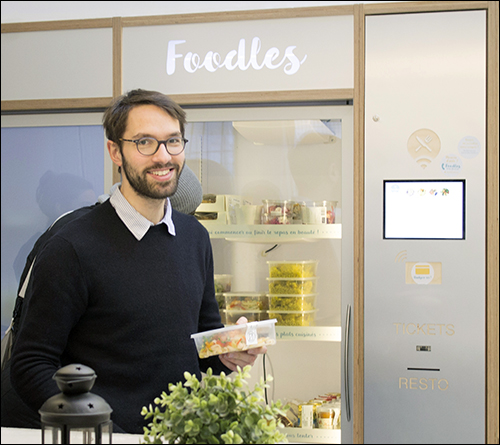When workers at some Parisian-area companies take their lunch or dinner breaks, they access fresh meals—such as chicken tagine or pork sauté in spices—out of a vending machine. The dining solution, provided by technology startup Foodles, allows them to pay for a meal with a Near Field Communication (NFC) tag, while the food selection for billing and inventory purposes is collected via ultrahigh-frequency (UHF) RFID technology. The result is a system that provides fresh food without the cost of preparation or point-of-sales staff. The vending-machine units enable companies to offer their workers the kinds of meals that large firms sell in on-campus canteens as an alternative to going offsite to restaurants.
The Paris-based technology firm was launched in 2014 with the aim of providing snack vending machines for mid-sized companies. However, it soon refocused its efforts on full meals that could be prepared by local restaurants or caterers, then be stocked daily in refrigerators at a company’s kitchen. Microwaves built into the same unit would then reheat those items.
To provide those meals, and to bill them to the appropriate employee, required technological intelligence, explains Paul Tsnobiladzé, the company’s CTO. The firm investigated options and found that the only existing technology that would serve their use-case was a weight-scale that could weigh items as they were stored on a shelf. If someone were to identify himself or herself with an ID badge, and then remove a plate or package of food from the shelf, the scale would detect the change in weight and bill that individual accordingly.
However, the company rejected this solution for several reasons, Tsnobiladzé says. For one thing, the system would need to be recalibrated daily if the food offerings changed, since each item has a different weight (a salad would not have the same weight as a meat entrée, for instance). In addition, the company wanted visibility into each individual item so that it could know, for instance, when each product was placed in the vending machine and, therefore, when it needed to be removed before it could expire.
That, Tsnobiladzé says, led the team to investigate RFID. “We started working on it in 2015,” he recalls, and had created a prototype, with an off-the-shelf UHF RFID reader built into the device and antennas on each shelf, within only a few months. After ensuring that the system was working reliably, the company began selling the solution to other businesses. To date, eight firms in the Paris area are, altogether, using 16 units for their employees.
Here’s how the system works: Foodles collects meals for every customer on a daily basis from supplier caterers and restaurants. Menus change weekly, and the company can request specific meals. Foodles offers everything from a quinoa salad to beef lasagna. Any items that require cooking are precooked and chilled, so that all food can be stored in the refrigeration unit.
Before delivering the food to a particular customer, Foodles’ staff attaches UHF RFID tags at specific locations on the products (each item requires that the tag be affixed at a different spot, in order to ensure the best transmission accuracy). Tsnobiladzé declines to name the specific tags being used; however, he says, the company spent considerable time testing tags (inlays and encapsulations), in order to determine the one that would work best, along with the proper attachment location for each type of food. High levels of liquids, as well as the need for some items to be packed closely together, make it challenging to read RFID tags, he explains.
The unique ID number encoded on each tag is linked to details about that item in Foodles’ software, including what type of dish it is, where it was prepared and when it will expire. The goods are then stocked in each unit at customers’ sites, while any expired items are removed. Each unit can accommodate approximately 200 products.
When an employee takes a lunch break, he or she taps a 13.56 MHz NFC-enabled ID card at the NFC reader built into the front of the refrigeration unit. Each worker’s ID is linked with his or her prepaid account, and is managed on Foodles’ server. Once the reader captures the employee’s ID number and forwards that information to the server, the ID is authenticated and the unit door unlocks automatically.
The user can then open the door and remove the desired items. The unit reader ceases to interrogate those tag IDs, and all items removed are displayed on the touch screen at the unit’s front. The individual agrees to the payment total, and that amount is deducted from his or her account. Foodles’ software can then update the unit’s inventory level. As a result, Tsnobiladzé says, “We know exactly what’s inside each fridge.”
In some cases, companies might share access to a Foodles unit within an office building that hosts multiple organizations. Typically, Tsnobiladzé says, more than one unit is acquired in such a scenario, so as to reduce queueing times during lunch or dinner hours. He adds that the company signs up two or three new customers each month. While the system is initially being used in France, he expects Foodles to expand its use to other parts of Europe, including the United Kingdom, by next year.
In the future, Foodles intends to employ analytics capabilities with the software to identify how foods are selling, at what volume and where sales are occurring, in order to improve the targeting of menus. As present, the company reports, food waste is as low as 5 percent, in part because the technology enables Foodles to identify the number of specific products required at each site, thereby reducing the risk of overstocking goods that could expire before being sold.


